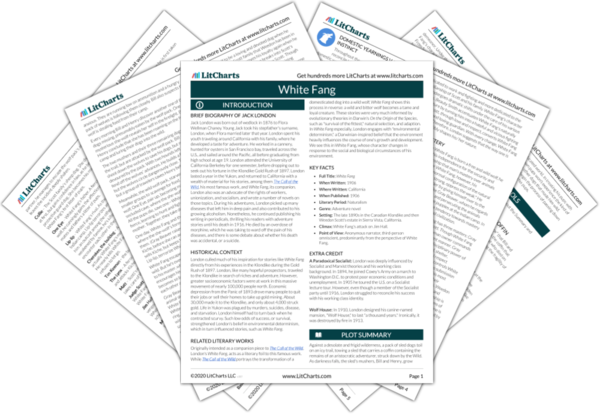The Struggle for Survival
White Fang's Wild Northland is a harsh and merciless place, where every living being struggles to survive. London illustrates this struggle by showing Bill and Henry's sled dog team mushing across the still and frozen Klondike. Against this cold and desolate expanse, they are the only signs of life. Even so, their sled tows a coffin, an ominous reminder that death could strike at any moment in this perilous place. The image shows the…
read analysis of The Struggle for SurvivalDomestic Yearnings v. Natural Instinct
Throughout the novel, White Fang struggles to reconcile his feral instincts with the expectations of the domestic world, highlighting the conflict between nature and society. Part wolf and raised in the wild, White Fang's natural instincts to fight and hunt are at odds with man's ways. For instance, White Fang bristles at being petted, or tied down with a leather thong by his human masters. Through these measures, humans expect and demand obedience and respect…
read analysis of Domestic Yearnings v. Natural InstinctNature v. Nurture
In White Fang, London prods a question at the core of "environmental determinism"—does nature determine our course, or does our environment play a greater role? Is nature, or nurture more decisive? London appears to come down on the side of nurture by suggesting that White Fang's character is a kind of "clay," shaped and molded by the circumstances he encounters and the people he meets. As White Fang's environment shifts his demeanor changes. In…
read analysis of Nature v. Nurture
Mastery
Though White Fang is born a free and wild wolf, he gives up his independence for the security and companionship that man's mastery over animals and matter provides. For White Fang, however, his subservience to man is a normal configuration of the natural code he lives by: "obey the strong, oppress the weak." He participates in this social order by giving himself over to the care of strong human lords, like Gray Beaver, whom…
read analysis of MasteryDomestication
From bitter and hateful beast to man's best friend, White Fang undergoes a process of domestication. He is born a wild wolf, becomes a morose and aloof pariah in the Indian camp, is trained as a vicious fighting dog under Beauty Smith, and finally transforms into a loving and loyal companion dog to Weedon Scott. Yet, White Fang becomes domesticated because he's trained, rather than tamed. Gray Beaver and Beauty tame…
read analysis of DomesticationMating and Parenthood
Parenthood begins and ends White Fang. The she-wolf, Kiche, and One Eye mate to become the parents of White Fang, while White Fang becomes a father in his own right when he has a litter of pups with Collie. Pups signal birth and new life, but mating and parenthood in White Fang are also closely associated with ferocity and violence. One Eye kills his rivals to mate with Kiche, while Kiche, out…
read analysis of Mating and Parenthood






